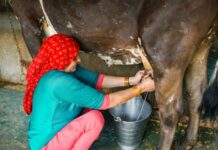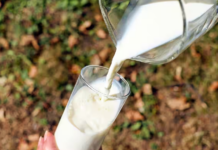New Delhi, October 14, 2023 : Milk production in India is set to soar.
India is expected to produce over 25 per cent of the world’s milk by next year, and by 2047, this is likely to rise to 50 per cent, according to Ramesh Chand, a member of the think-tank NITI Aayog.
Highlighting India’s expanding milk production, which is steadily increasing at an annual rate of 6 per cent, Mr Chand underscored the need for the nation to venture into global markets for its dairy products.
Milk production
A staggering 220 million tonnes of milk is produced in India each year, presenting both opportunities and challenges for the nation. While domestic demand for milk products remains strong, Mr Chand said international markets must be explored to ensure sustainable growth and decrease market fluctuations.
Speaking at the Indian Dairy Association’s Dairy Industry Conference in Gujarat, Mr Chand observed that 25 years ago, the United States outpaced India in milk production.
He said: “We have surpassed them to the extent that we now generate nearly twice as much milk as they do.”
Pointing out that it was time to tap into international markets with a focus on quality, Mr Chand said the strategy could help India’s dairy sector maintain a more consistent level of production and revenue.
More than 80m farmers were directly employed in India’s dairy sector, which contributes 5 per cent to the national economy. Retail prices for milk increased by 10 per cent year-on-year in June 2023.
The transition from focusing on exotic breeds to native, indigenous breeds since 2005 has worked in India’s favour and led to a significant boost in milk production. Consequently, per capita milk production in India now surpasses the domestic recommended daily dietary level of 377g.
Indian dairy
During 2021-22, India boasted a per capita milk availability of 444g per day, surpassing the global average of 394g.
However, the dairy sector faces a number of challenges, including low productivity of milking animals, increased emissions of greenhouse gases which contribute to climate change and a very low export share.
Milk exports were less than 0.5 per cent of domestic production. Global dairy exports reached a substantial US$63 billion (£52bn) in 2021, whereas India’s exports amounted to a modest US$392m (£323m), representing 0.62 per cent of the total.
Surging production costs, including dairy farming inputs and higher cattle feed prices – the latter making up a major portion of farmers’ expenses – were the other hurdles. The scarcity of fodder and price spikes in essential raw materials like maize and soybeans have turned cattle feed into an expensive commodity.
Looking to safeguard the interests of domestic stakeholders, India has taken a proactive stance in the ongoing negotiations for a Free Trade Agreement (FTA) with the United Kingdom. India has chosen to exclude two pivotal areas of contention: data-related matters and concessions related to the dairy sector. These decisions were indicative of India’s commitment to ensuring the FTA not only serves as a mutually beneficial agreement, but also safeguards its economic interests.
Pointing out that India being the largest global producer of milk has made notable strides in fulfilling its internal demand, Mr Chand said it was time to diversify the customer base beyond the border.
He highlighted the significance of fostering export competitiveness, adding the export of processed dairy products, as opposed to liquid milk in isolation, would be a more prudent strategy. This transition, he said, would necessitate certain investments within the dairy industry, including enhancements along the value chain.
Mr Chand also emphasised India’s potential to access high-end markets once it addresses concerns related to milk quality and livestock health.
according to the reports published in dairynews7x7.com .
Observing that milk and dairy products have been the real heroes in fighting nutritional gaps and improving health outcomes, especially among children and women, Mr Chand quoted from his paper on ‘India’s White Revolution’. The paper posited that the per capita consumption of milk and its derivatives in India has nearly doubled over the past two decades, highlighting milk as a major contributor to improved nutrition in the country.



























